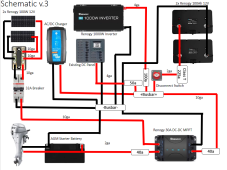I am installing 2x 100Ah lithium batteries, 2x 100watt solar panels, MPPT Charger, and a 1000W inverter in a sailboat with an existing DC panel. Attached is my (nearly complete) diagram. I don't have a lot of space where this is being installed and I want to minimize connections. Busbars were recommended on my other thread where I asked for feedback on the overall system. I'm having a hard time figuring out the best way to minimize connections and keep this as compact as possible. I'm planning to add a Class T fuse immediately after the batteries unless this is overkill. If I use a positive busbar, is there a good option for integrated fuses to the other devices? I'm looking at the Victron 6 position Mega fuse holder (https://www.victronenergy.com/upload/documents/Datasheet-Fuse-holder-6-way-MEGA-fuse-EN.pdf ) but the reviews are questionable. Is there anything else like this available? What are other options for a simple busbar / fuse holder? A normal busbar with separate fuse holders would add a lot of connections and bulk to this setup. Thanks!




